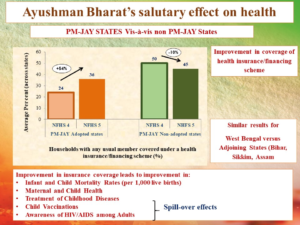- The relationship between inequality and socio-economic outcomes vis-à-vis economic growth and socio-economic outcomes, is different in India from that in advanced economies.
- Both inequality and per-capita income (growth) have similar relationships with socio-economic indicators in India, unlike in advanced economies
- Economic growth has a greater impact on poverty alleviation than inequality
- India must continue to focus on economic growth to lift the poor out of poverty
- Expanding the overall pie – redistribution in a developing economy is feasible only if the size of the economic pie grows
Healthcare takes centre stage, finally!
- COVID-19 pandemic emphasized the importance of healthcare sector and its inter-linkages with other sectors – showcased how a health crisis transformed into an economic and social crisis
- India’s health infrastructure must be agile so as to respond to pandemics – healthcare policy must not become beholden to ‘saliency bias’
- National Health Mission (NHM) played a critical role in mitigating inequity as the access of the poorest to pre-natal/post-natal care and institutional deliveries increased significantly
- Emphasis on NHM in conjunction with Ayushman Bharat should continue
- An increase in public healthcare spending from 1% to 2.5-3% of GDP can decrease the out-of-pocket expenditure from 65% to 35% of overall healthcare spending
- A regulator for the healthcare sector must be considered given the market failures stemming from information asymmetry
- Mitigation of information asymmetry will help lower insurance premiums, enable the offering of better products and increase insurance penetration
- Information utilities that help mitigate the information asymmetry in healthcare sector will be useful in enhancing overall welfare
- Telemedicine needs to be harnessed to the fullest by investing in internet connectivity and health infrastructure
JAY Ho! PM‘JAY’ Adoption and Health outcomes

- Pradhan Mantri Jan Arogya Yojana (PM-JAY) – the ambitious program launched by Government of India in 2018 to provide healthcare access to the most vulnerable sections demonstrates strong positive effects on healthcare outcomes in a short time
- PM-JAY is being used significantly for high frequency, low cost care such as dialysis and continued during the Covid pandemic and the lockdown.
- Causal impact of PM-JAY on health outcomes by undertaking a Difference-in-Difference analysis based on National Family Health Survey (NFHS)-4 (2015-16) and NFHS-5 (2019-20) is following:
- Enhanced health insurance coverage: The proportion of households that had health insurance increased in Bihar, Assam and Sikkim from 2015-16 to 2019-20 by 89% while it decreased by 12% over the same period in West Bengal
- Decline in Infant Mortality rate: from 2015-16 to 2019-20, infant mortality rates declined by 20% for West Bengal and by 28% for the three neighbouring states
- Decline in under-5 mortality rate: Bengal saw a fall of 20% while, the neighbours witnessed a 27% reduction
- Modern methods of contraception, female sterilization and pill usage went up by 36%, 22% and 28% respectively in the three neighbouring states while the respective changes for West Bengal were negligible
- While West Bengal did not witness any significant decline in unmet need for spacing between consecutive kids, the neighbouring three states recorded a 37% fall
- Various metrics for mother and child care improved more in the three neighbouring states than in West Bengal.
- Each of these health effects manifested similarly when we compare all states that implemented PM-JAY versus the states that did not
Overall, the comparison reflects significant improvements in several health outcomes in states that implemented PM-JAY versus those that did not
















